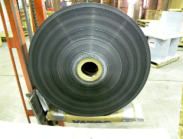MTi Polyexe, Blog, blown film, base films, release liner, plastic film, silicone coatings, silicone release liner, custom coating converting, plastics films, Blown Film Extrusion
Tags: blown film, blown film extrusion, silicone release liner, multi-layer film
Here at MTI Polyexe we want to wish you a happy Earth Day. We understand as a blown film extrusion manufacturer, silicone coating manufacturer and release liner manufacturer in today's day age it is more important than ever to understand we only have one planet thus we must keep it clean. You can count on us at MTI Polyexe to do just that along with delivery you a quality product. Thank you for taking the time to read this please look at our offerings.
Tags: silicone coatings, custom coating converting, blown film extrusion, silicone release liner, Earth Day
Blown Film Extrusion 
One of the most common methods of film manufacture is Blown Film (also referred to as the Tubular Film) Extrusion. The process involves extrusion of a plastic through a circular die, followed by "bubble-like" expansion. The principal advantages of manufacturing film by this process include the ability to:
|
The Process
Plastic melt is extruded through an annular slit die, usually vertically, to form a thin walled tube. Air is introduced via a hole in the centre of the die to blow up the tube like a balloon. Mounted on top of the die, a high-speed air ring blows onto the hot film to cool it. The tube of film then continues upwards, continually cooling, until it passes through nip rolls where the tube is flattened to create what is known as a ' lay-flat' tube of film. This lay-flat or collapsed tube is then taken back down the extrusion ' tower' via more rollers. On higher output lines, the air inside the bubble is also exchanged. This is known as IBS (Internal Bubble Cooling).
The lay-flat film is then either kept as such or the edges of the lay-flat are slit off to produce two flat film sheets and wound up onto reels. If kept as lay-flat, the tube of film is made into bags by sealing across the width of film and cutting or perforating to make each bag. This is done either in line with the blown film process or at a later stage.
Typically, the expansion ratio between die and blown tube of film would be 1.5 to 4 times the die diameter. The drawdown between the melt wall thickness and the cooled film thickness occurs in both radial and longitudinal directions and is easily controlled by changing the volume of air inside the bubble and by altering the haul off speed. This gives blown film a better balance of properties than traditional cast or extruded film which is drawn down along the extrusion direction only.
| 3 layer die head with air ring and internal bubble cooling | Film bubble going into a collapsing frame |
| Control panel graphic from an automated blown film line | Taking an edge trim from film web |
| The layflat tube is separated into 2 single sheets | Blown Film Line In Action |
Materials
Polyethylenes (HDPE, LDPE and LLDPE) are the most common resins in use, but a wide variety of other materials can be used as blends with these resins or as single layers in a multi-layer film structure. these include pp, pa, evoh. In some cases, these materials do not gel together, so a multi-layer film would delaminate. To overcome this, small layers of special adhesive resins are used in between. These are known as “tie layers”.
Tags: RELEASE FILMS, blown film, plastic film, Polyethylene, blown film extrusion, Polypropylene, converting, multi-layer film
Happy New Year! From all of us at MTI Polyexe!
Posted by Thomas Zickell on Sat, Dec 31, 2011 @ 15:12 PM
MTI Polyexe Corporation wants to thank you all for giving us a great 2011. We look forward to providing more innovative products and high quality service you have come to expect from us in 2012. If you are already a customer we are grateful for your loyalty. If you are not yet a customer and are looking for a company that can save you money and time please contact us.
Tags: RELEASE PAPERS, blown film, base films, release liner, plastic film, Polyolefins, Polyethylene, blown film extrusion, silicone release liner, Polypropylene, TPO, converting, rewinding services
Making Plastics
To make plastics, chemists and chemical engineers must do the following on an industrial scale:
Tags: anti skid, RELEASE PAPERS, RELEASE FILMS, FILMS - Coextrusion, FILMS - Polyethylene, FILMS - Polypropylene, blown film, base films, custom coating converting, Polyolefins, blown film extrusion, Film slitting, How plastics work
Thank you for making the summer of 2011 great MTI Polyexe.
Posted by Thomas Zickell on Fri, Sep 02, 2011 @ 14:09 PM
MTi Polyexe Corporation would like to thank every one for taking the time to visit our site. from mtipolyexe on Vimeo.
Tags: anti skid, RELEASE PAPERS, RELEASE FILMS, FILMS - Coextrusion, HDPE, LDPE, LLDPE, blown film, base films, release liner, plastic film, silicone coatings, custom coating converting, Polyethylene, blown film extrusion
MTi Polyexe would like to thank you for visiting our Blog.
Posted by Thomas Zickell on Wed, Aug 24, 2011 @ 03:08 AM
MTi Polyexe Corporation would like to thank every one for taking the time to visit our site.
Tags: anti skid, RELEASE PAPERS, RELEASE FILMS, FILMS - Coextrusion, FILMS - Ethyl Vinyl Acetate, FILMS - Polyethylene, LDPE, FILMS - Polypropylene, blown film, base films, release liner, plastic film, silicone coatings, custom coating converting, Polyolefins, Polyethylene, blown film extrusion
Please tell use what you think of our awards.
Tags: anti skid, RELEASE PAPERS, base films, release liner, silicone coatings, custom coating converting, Polyethylene, blown film extrusion, silicone release liner, Polypropylene
Tags: anti skid, blown film, base films, release liner, plastic film, silicone coatings, custom coating converting, Polyolefins, blown film extrusion, silicone release liner
Welcome To MTI Polyexe Blog, Blown Film Extrusion Silicone coating
Posted by Mike Sullivan on Wed, May 25, 2011 @ 23:05 PM

Tags: anti skid, blown film, base films, release liner, plastic film, silicone coatings, custom coating converting, Polyolefins, Polyethylene, blown film extrusion, silicone release liner, Polypropylene, TPO






